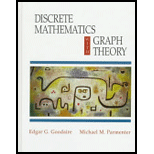
Concept explainers
(a)
The type of scheduling problem is this.
When a customer places an order with a food delivery service, a phone operator keys (K) in the order. This requires 3 units of time and must be done first. Other employees of the store then shop for the frozen goods (F) the dry goods (D), and the produce (P) that have been ordered. The frozen goods are bagged (BF) separately from the produce and dry goods (PD), and then everything is loaded (L) onto the delivery truck. Shopping is the frozen goods requires 3 units of time if done right alter the order is taken, and otherwise 5 units of time. Takes 4 units of time to shop for the dry goods. The produce is selected immediately after the dry goods and takes 7 units of time. It takes 2 units of time to pack the frozen goods if this occurs immediately after they are selected and otherwise 3 units of time. Packing the dry goods requires 2 units of time if the frozen goods have not yet been packed, and otherwise 3 units. Loading the truck takes 8 units of time if the frozen goods were packed before the dry goods, and otherwise 11 units of time.
(b)
To graph: A network that describes this situation.
When a customer places an order with a food delivery service, a phone operator keys (K) in the order. This requires 3 units of time and must be done first. Other employees of the store then shop for the frozen goods (F) the dry goods (D), and the produce (P) that have been ordered. The frozen goods are bagged (BF) separately from the produce and dry goods (PD), and then everything is loaded (L) onto the delivery truck. Shopping is the frozen goods requires 3 units of time if done right alter the order is taken, and otherwise 5 units of time. Takes 4 units of time to shop for the dry goods. The produce is selected immediately after the dry goods and takes 7 units of time. It takes 2 units of time to pack the frozen goods if this occurs immediately after they are selected and otherwise 3 units of time. Packing the dry goods requires 2 units of time if the frozen goods have not yet been packed, and otherwise 3 units. Loading the truck takes 8 units of time if the frozen goods were packed before the dry goods, and otherwise 11 units of time.
(c)
The shortest amount of time this process will take. Apply Dijsktra’s algorithm (first form) to discover how to get the groceries on their way to the customer as quickly as possible.
When a customer places an order with a food delivery service, a phone operator keys (K) in the order. This requires 3 units of time and must be done first. Other employees of the store then shop for the frozen goods (F) the dry goods (D), and the produce (P) that have been ordered. The frozen goods are bagged (BF) separately from the produce and dry goods (PD), and then everything is loaded (L) onto the delivery truck. Shopping is the frozen goods requires 3 units of time if done right alter the order is taken, and otherwise 5 units of time. Takes 4 units of time to shop for the dry goods. The produce is selected immediately after the dry goods and takes 7 units of time. It takes 2 units of time to pack the frozen goods if this occurs immediately after they are selected and otherwise 3 units of time. Packing the dry goods requires 2 units of time if the frozen goods have not yet been packed, and otherwise 3 units. Loading the truck takes 8 units of time if the frozen goods were packed before the dry goods, and otherwise 11 units of time.
Want to see the full answer?
Check out a sample textbook solution
Chapter 11 Solutions
Discrete Mathematics with Graph Theory (Classic Version) (3rd Edition) (Pearson Modern Classics for Advanced Mathematics Series)
 Calculus For The Life SciencesCalculusISBN:9780321964038Author:GREENWELL, Raymond N., RITCHEY, Nathan P., Lial, Margaret L.Publisher:Pearson Addison Wesley,
Calculus For The Life SciencesCalculusISBN:9780321964038Author:GREENWELL, Raymond N., RITCHEY, Nathan P., Lial, Margaret L.Publisher:Pearson Addison Wesley, Linear Algebra: A Modern IntroductionAlgebraISBN:9781285463247Author:David PoolePublisher:Cengage Learning
Linear Algebra: A Modern IntroductionAlgebraISBN:9781285463247Author:David PoolePublisher:Cengage Learning College AlgebraAlgebraISBN:9781305115545Author:James Stewart, Lothar Redlin, Saleem WatsonPublisher:Cengage Learning
College AlgebraAlgebraISBN:9781305115545Author:James Stewart, Lothar Redlin, Saleem WatsonPublisher:Cengage Learning- Algebra & Trigonometry with Analytic GeometryAlgebraISBN:9781133382119Author:SwokowskiPublisher:Cengage
 Algebra: Structure And Method, Book 1AlgebraISBN:9780395977224Author:Richard G. Brown, Mary P. Dolciani, Robert H. Sorgenfrey, William L. ColePublisher:McDougal Littell
Algebra: Structure And Method, Book 1AlgebraISBN:9780395977224Author:Richard G. Brown, Mary P. Dolciani, Robert H. Sorgenfrey, William L. ColePublisher:McDougal Littell Elementary Geometry For College Students, 7eGeometryISBN:9781337614085Author:Alexander, Daniel C.; Koeberlein, Geralyn M.Publisher:Cengage,
Elementary Geometry For College Students, 7eGeometryISBN:9781337614085Author:Alexander, Daniel C.; Koeberlein, Geralyn M.Publisher:Cengage,





